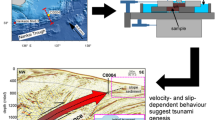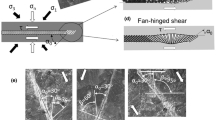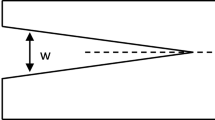Abstract
Weakening of a prestressed sawcut in Westerly granite under laboratory condition is accomplished by injecting pressurized fluid into the sawcut. After injection a sequence of stick-slips is observed while the deviatoric stress decreases successively with each stick-slip. On the basis of the experimental observation we develop a model of fault instability due to inhomogeneous and progressive weakening of the fault. According to this model, the fault surface is divided into the ‘slipped’ and the ‘locked’ regions, depending on whether or not the local state of stress satisfies the friction criterion. The average shear stress in the slipped region decreases with time and, in order to maintain a quasi-static equilibrium, shear stress in the remaining ‘locked’ region on the fault surface increases. This situation may last until a critical state of stress on the fault is met, at which a sudden instability (stick0slip) may occur. We suggest that this mechanism of stress transfer may be a viable mechanism of induced seismicity and aftershocks, in addition to the well-known mechanism of a local increase of pore pressure. By comparing the experimental data with model predictions we show that the critical condition for slip instability is when the average shear stress over the ‘locked’ region becomes equal to the value given by the friction criterion. Thus the friction criterion established for slip on fractures on which the state of stress is macroscopically uniform may also be applicable to fractures on which the stress state is macroscopically heterogeneous.
Similar content being viewed by others
References
Bell, M. L., andNur, A. (1978),Strength Changes Due to Reservoir-Induced Pore Pressure and Stresses and its Application to Lake Oroville, J. Geophys. Res.83, 4469.
Booker, J. R. (1974),Time Dependent Strain Following Faulting of a Porous Medium, J. Geophys. Res.,79, 2037.
Brace, W. F. (1965),Some New Measurements of Linear Compressibility of Rocks, J. Geophys. Res.,70, 391.
Brace, W. F., andByerlee, J. D. (1966),Stick-Slip as a Mechanism for Earthquakes, Science153, 990.
Brace, W. F., Walsh, J. B., andFrangos, W. T. (1968),Permeability of Granite Under High Pressure, J. Geophys. Res.73, 2225.
Brar, N. S., andStesky, R. M. (1980),Permeability of Intact and Jointed Rock, EOS61 (46), 112.
Byerlee, J. D. (1967),Frictional Characteristics of Granite Under High Confining Pressure, J. Geophys. Res.72, 341.
Byerlee, J. D. (1978),Friction of Rocks, Pure Appl. Geophys.116, 615.
Carslaw, H. S., andJaeger, J. C.,Conduction of Heat in Solids, 2nd ed. (Oxford Univ. Press, London 1959).
Dieterich, J. H. (1978),Time-Dependent Friction and the Mechanics of Stick-Slip, Pure Appl. Geophys.116, 790.
Dieterich, J. H. (1979a),Modelling of Rock Friction: I. Experimental Results and Constitutive Equations, J. Geophys. Res.84, 2161.
Dieterich, J. H. (1979b),Modelling of Rock-Friction: I. Simulation of Preseismic Slip, J. Geophys. Res.84, 2169.
Dieterich, J. H. (1981),Constitutive Properties of Faults with Simulated Gouge. InMechanical Behavior of Crustal Rocks, Am. Geophys Monog.24, 103.
Engelder, T., andScholz, C. H. (1981),Fluid Flow Along Very Smooth Joints at Effective Pressure up to 200 Megapascals. InMechanical Behavior of Crustal Rocks, The Handin Volume (eds N. L. Carter, M. Friedman, J. M. Logan, D. W. Stearns), Am. Geophys. Un. Monog,24, Washington, D.C., 147.
Fletcher, J. B., andSykes, L. R. (1977),Earthquakes Related to Hydraulic Mining and Natural Seismic Activity in Western New York State, J. Geophys. Res.82, 3767.
Hamilton, R. M., andHealy, J. H. (1969),Aftershocks of the Benham Nuclear Explosion, Bull. Seismol. Soc. Amer.59, 2271.
Kranz, R. L., Frankel, A. D., Engelder, T., andScholz, C. H. (1979),The Permeability of Whole and Jointed Barre Granite, Int. J. Rock Mech. Min. Sci. & Geomech. Abstr.16, 225.
Lachenbruch, A. H., andSass, J. H. (1980),Heat Flow and Energetics of the San Andreas Fault Zone, J. Geophys. Res.85, 6185.
Li, V. C. (1983),Estimation of In Situ Diffusivity, MIT Report No. R83-12.
Logan, J. M., Higgs, N. G., and Friedman, M. (1981),Laboratory Studies on Natural Gouge from the USGS No. 1 Well in the San Andreas Fault Zone. InMechanical Behavior of Crustal Rocks, Am. Geophys. Un. Monog.24, 121.
Nur, A., andByerlee, J. D. (1971),An Exact Effective Stress Law for Elastic Deformation of Rock With Fluids, J. Geophys. Res.76, 6414.
Nur, A., andBooker, J. R. (1972),Aftershocks Caused by Pore Fluid Flow?, Science175, 885.
Ohtake, M. (1974),Seismic Activity Induced by Water Injection at Matsushiro, Japan, J. Phys. Earth.22, 163.
Raleigh, C. B., Healy, J. H., andBredehoeft, J. D. (1976),An Experiment in Earthquake Control at Rangely, Colorado, Science191, 1230.
Raleigh, C. B. (1977),Frictional Heating, Dehydration and Earthquake Stress Drops InProc. of Conference II: Experimental Studies of Rock Friction with Application to Earthquake Prediction, U.S. Geol. Survey, Menlo Park, Calif., p. 291.
Raleigh, B., andEvernden, J. (1981),Case for Low Deviatoric Stress in the Lithosphere, InMechanical Behavior of Crustal Rocks, The Handin Volume (eds N. L. Carter, M. Friedman, J. M. Logan D. W. Stearns), Am. Geophys. Un. Monog.24, Washington, D.C. 173.
Ruina, A. L. (1983),Slip Instability and State Variable Friction Laws, J. Geophys. Res.88, 10359.
Sibson, R. H. (1973),Interactions Between Temperature and Pore-Fluid Pressure During Earthquake Faulting and a Mechanism for Partial or Total Stress Relief, Nature243, 66.
Solberg, P., andByerlee, J. D. (1984),A Note on the Rate Sensitivity of Frictional Sliding of Westerly Granite, J. Geophys. Res., in press.
Stesky, R. M. (1978),Mechanisms of High Temperature Frictional Sliding in Westerly Granite, Can. J. Earth Sci.15, 361.
Stesky, R. M., Brace, W. F., Riley, D. K., andRobin, P. Y. F. (1974),Friction in Faulted Rock at High Temperature and Pressures, Tectonophysics23, 177.
Summers, R., andByerlee, J. D. (1977),A Note on the Stability of Frictional Sliding, Int. J. Rock Mech. Sci.14, 155.
Talwani, P., andAcree, S. (1984),Pore Pressure Diffusion and the Mechanism of Reservoir Induced Seismicity, Pageoph (in press).
Tullis, T. E., andWeeks, J. D. (1984),Constitutive Behavior and Stability of Frictional Sliding of Granite, J. Geophys. Res.
Walsh, J. B. (1981),Effect of Pore Pressure and Confining Pressure on Fracture Permeability, Int. J. Rock Mech. Min. Sci. & Geomech. Abstr.18, 429.
Wang, C., andMao, N. (1979),Shearing of Saturated Clays in Rock Joints at High Confining Pressures, Geophys. Res. Lett.6, 825.
Weeks, J. D., andTullis, T. E. (1984),Frictional Sliding of Calcite: An Interesting Variation in Constitutive Behavior, Geophys. Res. Lett., in press.
Author information
Authors and Affiliations
Rights and permissions
About this article
Cite this article
Shi, X.J., Wang, C.Y. Instability on a weakening fault. PAGEOPH 122, 478–491 (1984). https://doi.org/10.1007/BF00874613
Received:
Revised:
Accepted:
Issue Date:
DOI: https://doi.org/10.1007/BF00874613




